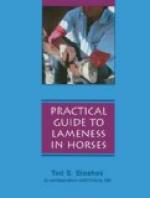Where treatment is instituted, it is found that there is required a long time for union of the fractured bones to occur (where union does take place) and the cost of treatment together with the uncertainty of even partial recovery, makes for an unfavorable outcome. When the best possible results succeed treatment, a large callosity is formed and movement of the pastern joint is restricted. Lameness, though not intense, in the case referred to, where one bone was broken, was permanent and the subject was out of service for nearly a year.
Inflammation of the Posterior Ligaments of the Pastern (Proximal Interphalangeal) Joint.
Anatomy.—The ligaments here involved are the four volar ligaments described by Sisson[24] as follows: “The volar ligaments (Ligg Volaria) consist of a central pair and a lateral and medial bands which are attached below to the posterior margin of the proximal end of the second phalanx and its complementary fibro-cartilage. The lateral and medial ligaments are attached above to the middle of the borders of the first phalanx, the central pair lower down and on the margin of the triangular rough area.”
This portion of the inhibitory apparatus is described by Strangeways’ Anatomy as two posterior ligaments which run each from three points on the sides of the os suffraginis to a piece of fibro cartilage, described as the glenoid cartilage, and attached to the postero-superior edge of the os coronae; between them is the insertion of the inferior sesamoidean ligament.
Etiology and Occurrence.—Everything tending to increase strain upon these ligaments is contributory to possible fibrillary fracture of these structures. Excessive leverage as furnished by long toes, long toe-calks and low heels increases the normal tension on the posterior ligaments of the pastern joint. Faulty conformation, which throws an abnormal strain on these ligaments, is a predisposing cause of inflammation of these structures. Hard pulling upon slippery and rough or frozen roads is a common exciting cause of this injury. The condition is of comparatively frequent occurrence and is seen affecting draft horses frequently, in the hind legs.
Symptomatology.—Lameness is the first manifestation of this affection and weight bearing is painful in direct proportion to the extent of injury present. Volar flexion of the phalanges relieves tension on the parts; therefore, this position is assumed while the subject is at rest. When considerable tissue has been ruptured, and the condition is very painful, the foot is held off the ground as in all painful affections of the extremity.
By palpation evidence of pain is discernible, though very little swelling occurs. Pain is increased by manual tension of the parts which is done by grasping the toe of the foot and exerting traction on the flexor apparatus. Care must be taken in executing such manipulations, and it is only by comparison of the affected member with the sound one and noting the difference in the manifestations of discomfort that we may arrive at the proper conclusion.




